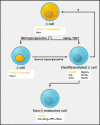Diabetic β Cells: To Be or Not To Be?
- PMID: 22980973
- PMCID: PMC4692270
- DOI: 10.1016/j.cell.2012.08.021
Diabetic β Cells: To Be or Not To Be?
Abstract
β cell dysfunction with subsequent apoptosis is considered a significant contributor to the development of type 2 diabetes. Emerging data from Talchai et al. suggest β cell dedifferentiation as an alternative mechanism of insulin insufficiency that might be more amenable to intervention in at least a subset of patients.
Copyright © 2012 Elsevier Inc. All rights reserved.
Figures

Comment on
-
Pancreatic β cell dedifferentiation as a mechanism of diabetic β cell failure.Cell. 2012 Sep 14;150(6):1223-34. doi: 10.1016/j.cell.2012.07.029. Cell. 2012. PMID: 22980982 Free PMC article.
References
-
- Buteau J, Accili D. Diabetes Obes. Metab. 2007;9(Suppl 2):140–146. - PubMed

